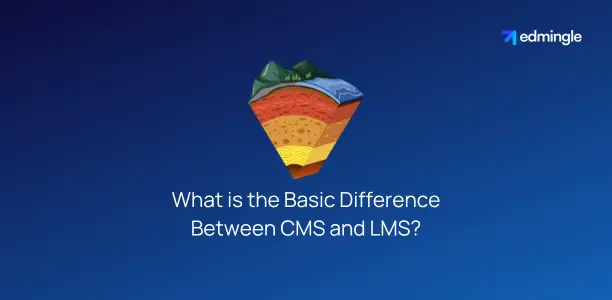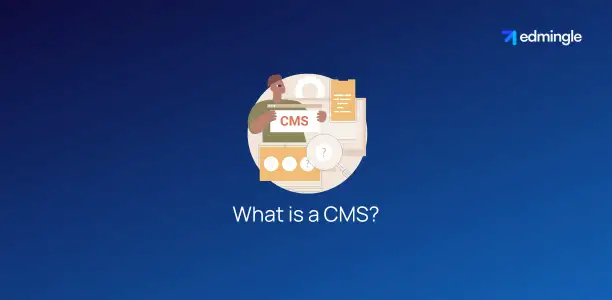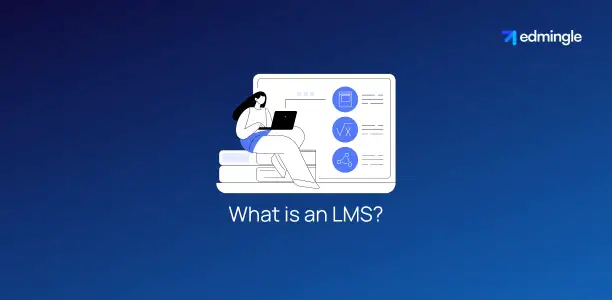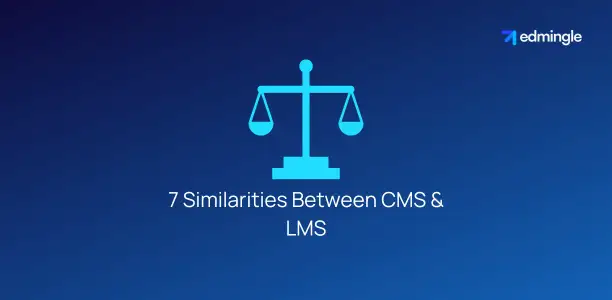
The acronyms “CMS” and “LMS” are often thrown around. Especially when discussing platforms for content creation and e-learning.
But what do they really mean & what is the key difference between CMS and LMS?
While both systems play pivotal roles. Understanding their unique functionalities and purposes can be a game-changer.
In this comprehensive guide, we’ll undergo a holistic comparison of CMS vs LMS. Diving deep into their distinct features, benefits and ideal use cases.
What is the Basic Difference Between CMS and LMS?

A content management system (CMS) is designed for creating, managing and publishing digital content. It focuses on websites and blogs, facilitating content creation and collaboration.
A learning management system (LMS), on the other hand, is tailored for educational content delivery, tracking, and management. It provides tools for course creation, enrollment and assessment.
Also Read: Difference Between LMS and TMS.
What is a CMS?

A CMS is a software platform designed to facilitate the creation, modification, organization and publication of online content.
Primarily used for web content. A CMS allows users, even those without technical expertise, to manage the content of a website with ease.
It typically provides a user-friendly interface where users can edit text, add images and arrange content elements without needing to write code.
Benefits of a CMS:
- User-Friendly: Allows individuals without technical expertise. To create, manage and publish various types of content on a website seamlessly.
- Cost-Efficient: Reduces the need for frequent developer intervention. Hence, leading to cost savings in website management.
- Consistent Branding: Templates and themes ensure a consistent look and feel across the website. Thus reinforcing branding.
- Collaboration: Multiple authors or contributors can work simultaneously. This way it streamlines content creation and publication.
- SEO Advantages: Built-in SEO tools can enhance the visibility of content in search engines. Thereby, driving organic traffic.
- Scalability: Can grow with the needs of the business by accommodating more content, features or traffic.
- Content Organization: Categorization, tagging and search functionalities make content easily accessible for visitors.
Since we talked about cost-efficiency. You’ll be thrilled to know that using Edmingle as an LMS helps reduce your operational cost by 20%.
Limitations of a CMS:
| 1.Some platforms can be complex for absolute beginners. | 4.The use of multiple plugins or extensions can sometimes lead to conflicts, causing features to break. |
| 2.As content grows and plugins are added, some CMS platforms can become sluggish. Or face performance issues. | 5.While CMSs offer customization, deep customization might require coding knowledge. |
| 3.Popular CMS platforms can be targets for hackers. Regular updates are essential, but they can sometimes introduce new vulnerabilities. | 6.Updates can sometimes break the site or make certain plugins incompatible. |
Features of a CMS:
| Web Content Creation & Editing | Template Management | SEO Tools | Media Libraries | Multi-language Support |
| Version Control | User Role Management | Content Scheduling | Extensions/Plugins | Backup and Restore |
Examples of CMSs:
WordPress, Joomla, Drupal, Squarespace & Wix are some of the popular CMS examples.
What is an LMS?

An LMS is a specialized software application/platform. Designed for the administration, documentation, tracking, reporting and delivery of educational courses or training programs.
It provides educators and trainers with a centralized and automated learning process. To create online courses and monitor learners’ progress. Users can then access online learning content, take assessments and receive feedback, all within the same platform.
LMSs are widely used in educational institutions for online learning. As well as in corporate settings for training and professional development.
Benefits of an LMS:
- Centralized Learning: Provides a single platform for storing, managing, and accessing educational content.
- Flexible Learning: Allows learners to access courses at their own pace and from anywhere. Hence, catering to diverse learning needs.
- Tracking & Level of Reporting: Offers insights into learner progress, performance, and areas of improvement. Thereby enabling tailored training/learning paths.
- Cost-Effective: Reduces costs associated with traditional classroom training. Such as travel, venue and printed materials.
- Standardized Content: Ensures that all learners receive the same quality of content and consistent training.
- Interactive Learning: Incorporates multimedia, quizzes and interactive modules to enhance engagement and retention.
- Customization: White label LMS platforms can be tailored to meet specific branding needs.
- Collaborative Learning: Discussion forums and group projects foster a sense of community and social learning.
Limitations of an LMS:
| 1.Some LMS platforms can be complex and require training to use effectively. | 4.Not all LMS platforms are optimized for mobile learning. This can limit accessibility for learners on the go. |
| 2.Not all LMS platform options integrate seamlessly with other tools or systems. | 5.As the number of users grows, some LMS platforms might face performance issues. |
| 3.While many LMSs are customizable, deep customization might be challenging or costly. | 6.Transferring content from one LMS to another, in proprietary formats, can be challenging. |
| 7.High-quality LMS platforms can be expensive, especially for small businesses or individual educators. LMS pricing is an important factor to consider. | |
Features of an LMS:
| Course Creation | Assessment | Collaboration | E-learning | Personalization |
| Training | Reporting & Analytics Features | Content Storage | Certification | Mobile Access |
Examples of LMSs:
Edmingle, Moodle, Blackboard Learn, Canvas & TalentLMS are some of the popular LMS examples.
Then, What is an LCMS?

Before moving forward with the difference between CMS and LMS, there’s one more trending acronym. Its an LCMS.
An LCMS is short for Learning Content Management System. It is a software platform that combines the features of both LMS and CMS.
It focuses on the collaborative creation and management of e-learning content. Users can often design, edit, and publish courses within the system. Hence, allowing for real-time updates and content reuse.
These platforms provide content authoring tools, template design and version control. And hence ensure consistent and up-to-date educational/training materials for learners.
In short, an LCMS = an LMS + a CMS.
8 Key Difference Between CMS & LMS (CMS vs LMS)
The table below highlight the key differences between both the systems for a clear understanding.
| Aspect | CMS | LMS |
| 1.Primary Purpose | Built to create, manage and publish online content, primarily for websites. | Designed specifically for delivering, tracking and managing e-learning courses and training programs. |
| 2.Content Type | Manages web pages, personal blog posts, images, videos and other web content. | Focuses both on online & offline learning materials, quizzes, student progress tracking and course registration. |
| 3.User Interaction | Primarily used by content creators and website administrators to update and manage website content. | Allows learners to enroll in courses, take assessments and receive feedback. |
| 4.Features | Provides tools for content creation, editing, publishing, SEO optimization and template management. | Offers LMS features like course enrollment, progress tracking, assessments, certifications and discussion forums. |
| 5.Collaboration | It can support user comments and multi-author platforms. | Often includes collaborative tools for learners, such as discussion boards and group projects. |
| 6.Feedback & Assessment | Lacks built-in tools for assessments and feedback related to learning outcomes. | Integral for providing feedback on student performance & understanding through quizzes, tests and assignments. |
| 7.Integration | Often integrates with a variety of plugins or extensions for added website functionality. | Might integrate with other educational tools or platforms. |
| 8.Target Audience | Web developers, content creators, bloggers, businesses and general web users. | Primarily educators, trainers, students and employees. |
While both platforms manage and deliver content. Their functionalities and purposes are distinct. Hence, catering to different audiences and types of content.
The choice between them depends on the specific needs of the user or organization. In a nutshell, CMSs are more for passive learning while LMSs aid active learning.
Read about Active vs. Passive Learning.
7 Similarities Between CMS & LMS

When we look at the core functions of both CMS and LMS, we find several genuine similarities. So here are they:
- Content Centralization: They serve as centralized repositories. Where content can be stored, organized and managed.
- User Management: Both platforms typically allow administrators to manage user roles and permissions. Hence, determining who can access, edit or manage certain content or sections.
- Web Accessibility: A CMS and an LMS are primarily web-based. They allow users and administrators to access content and functions from anywhere with an internet connection.
- Customizability: Both systems often support customization, whether through plugins or through integrations and add-ons.
- Structured Templates: Both systems utilize templates or predefined structures to ensure consistency in content presentation.
- Multimedia & Interactive Features: Both support multimedia content with interactive elements like quizzes or comment sections.
- Backup and Recovery: Recognizing the importance of the content they manage. Both platforms often feature tools for data backup and recovery.
Their shared goal of managing and delivering content results in these genuine, foundational similarities.
Also read about LMS Security Features.
Which is Best for You: LMS vs CMS?
Choosing between a CMS and an LMS depends on your primary objectives and needs. Consider the following points to make an informed decision
| 1.Content vs. Courses | If you’re primarily looking to publish and manage content like articles, blogs or web pages, a CMS is your go-to. If your focus is on delivering and managing educational content, opt for an LMS. |
| 2.User Interaction | For more general user interaction like comments on articles or product reviews, a CMS is suitable. For structured interactions like course discussions, assessments and feedback, an LMS is more appropriate. |
| 3.Functionality Needs | If you require tools for quizzes, student tracking and certifications, an LMS is essential. If you need a platform for general content publication with SEO tools and plugins, a CMS is the better choice. |
In short, the decision between LMS and CMS boils down to your primary objectives. And the above table helps you make an informed decision between both.
Summary
The tools we choose to manage and deliver content can make all the difference. And in such a scenario, understanding the difference between CMS and LMS platforms is crucial.
Both options serve distinct purposes and offer a plethora of features. Both can effectively elevate user experience and streamline content management. But for their own purposes or use cases.
To make the most out of these platforms, its essential to align your choice with your objectives.
FAQs around Difference Between LMS and CMS
1.Can an LMS & a CMS be used together?
Many organizations integrate their LMS with a CMS. To combine the strengths of both platforms. This allows them to manage and deliver online training content while maintaining a robust web presence.
2.Which one is more suitable for eLearning, LMS or CMS?
An LMS is more suitable for e-learning if you’re planning to deliver active learning formats. This includes online courses and training programs. But for passive learning formats like blogs and articles, a CMS will be a better choice. But remember, an LMS offers features like assessments, learner tracking and course management that a CMS doesn’t inherently possess.

Leave a Reply